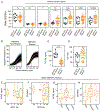Oral desensitization therapy for peanut allergy induces dynamic changes in peanut-specific immune responses
- PMID: 35266148
- PMCID: PMC9356972
- DOI: 10.1111/all.15276
Oral desensitization therapy for peanut allergy induces dynamic changes in peanut-specific immune responses
Abstract
Background: The PALISADE study, an international, phase 3 trial of peanut oral immunotherapy (POIT) with AR101, resulted in desensitization in children and adolescents who were highly allergic to peanut. An improved understanding of the immune mechanism induced in response to food allergen immunotherapy would enable more informed and effective therapeutic strategies. Our main purpose was to examine the immunological changes in blood samples from a subset of peanut-allergic individuals undergoing oral desensitization immunotherapy with AR101.
Methods: Blood samples obtained as part of enrollment screening and at multiple time points during PALISADE study were used to assess basophil and CD4+ T-cell reactivity to peanut.
Results: The absence of clinical reactivity to the entry double-blinded placebo-controlled peanut challenge (DBPCFC) was accompanied by a significantly lower basophil sensitivity and T-cell reactivity to peanut compared with DBPCFC reactors. At baseline, peanut-reactive TH2A cells were observed in many but not all peanut-allergic patients and their level in peripheral blood correlates with T-cell reactivity to peanut and with serum peanut-specific IgE and IgG4 levels. POIT reshaped circulating peanut-reactive T-cell responses in a subset-dependent manner. Changes in basophil and T-cell responses to peanut closely paralleled clinical benefits to AR101 therapy and resemble responses in those with lower clinical sensitivity to peanut. However, no difference in peanut-reactive Treg cell frequency was observed between groups.
Conclusion: Oral desensitization therapy with AR101 leads to decreased basophil sensitivity to peanut and reshapes peanut-reactive T effector cell responses supporting its potential as an immunomodulatory therapy.
Keywords: CD4+ T cells; Th2A cells; basophils; oral immunotherapy; peanut allergy.
© 2022 European Academy of Allergy and Clinical Immunology and John Wiley & Sons Ltd.
Conflict of interest statement
Figures






References
-
- Sicherer SH, Sampson HA. Food allergy: A review and update on epidemiology, pathogenesis, diagnosis, prevention, and management. The Journal of allergy and clinical immunology. 2018;141(1):41–58. - PubMed
-
- Dunlop JH, Keet CA. Epidemiology of Food Allergy. Immunol Allergy Clin North Am. 2018;38(1):13–25. - PubMed
-
- Gupta RS, Springston EE, Warrier MR, Smith B, Kumar R, Pongracic J, et al. The prevalence, severity, and distribution of childhood food allergy in the United States. Pediatrics. 2011;128(1):e9–17. - PubMed
-
- Peters RL, Koplin JJ, Gurrin LC, Dharmage SC, Wake M, Ponsonby AL, et al. The prevalence of food allergy and other allergic diseases in early childhood in a population-based study: HealthNuts age 4-year follow-up. The Journal of allergy and clinical immunology. 2017;140(1):145–53 e8. - PubMed
-
- Baker MG, Sampson HA. Phenotypes and endotypes of food allergy: A path to better understanding the pathogenesis and prognosis of food allergy. Ann Allergy Asthma Immunol. 2018;120(3):245–53. - PubMed
Publication types
MeSH terms
Substances
Grants and funding
LinkOut - more resources
Full Text Sources
Medical
Molecular Biology Databases
Research Materials

